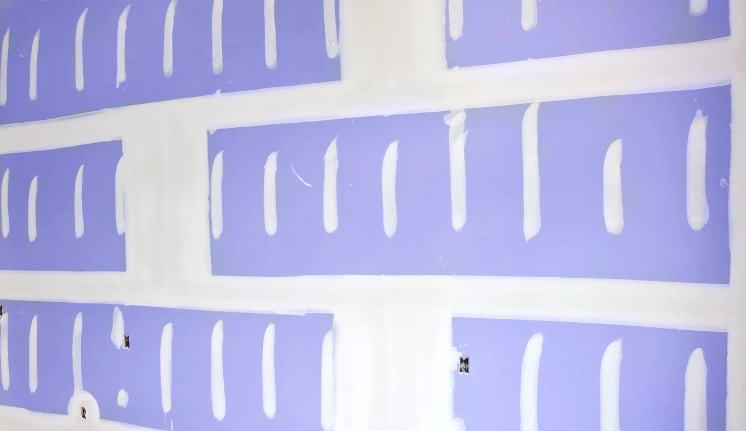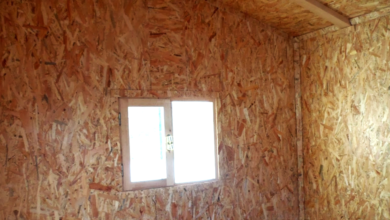Purple Drywall Issues

Purple drywall differs from other types of wallboard. Purple gypsum board offers more inventive features than regular drywall, although sharing characteristics like fire resistance and the ability to create flat surfaces on walls and ceilings. For example, it resists mold and dampness.
If you intend to install drywall in your home, it’s a great option, particularly in high-moisture areas like the kitchen or bathroom. Nevertheless, despite its remarkable qualities, purple drywall has been known to have a few problems.
This article’s goal is to inform you about these purple drywall issues so you can decide if it’s the right drywall for your project.
Let’s begin by providing a brief definition of purple drywall.
Without first explaining what purple drywall is, it would be unfair to go right to the issues.
One of National Gypsum’s brands, Gold Bond Building Products, produces purple wallboard. This type of drywall is made of gypsum and is resistant to moisture, mold, and fire.
It works far better than ordinary drywall and is resistant to moisture. Certain varieties of purple gypsum boards are renowned for their exceptional durability and ability to withstand dents, scratches, and scuffs.
Gold Bond offers a variety of purple drywall options, such as XP Hi-Abuse Drywall, PURPLE XP Drywall, SoundBreak XP Ceiling Board, and XP Hi-Impact Drywall.
Purple drywall can be used in any space of your home, despite its ability to endure any kind of weather. It is preferred by many builders and homeowners for usage in high-humidity spaces including the kitchen, basement, and bathroom.
What are a Few of the Typical Issues with Purple Drywall?
-
1. The cost is high.
The price of purple drywall is the first concern that most people have. Did you know that a typical panel of drywall costs between $12 and $20? Purple drywall, on the other hand, often costs between $15 and $60 per panel.
Suppose you have a large project that requires a lot of purple plasterboard. In comparison to ordinary drywall, the whole cost will be doubled or tripled.
Because purple gypsum board offers additional properties like mold and water resistance, its high price shouldn’t be shocking. These characteristics help to extend the shelf life of the purple drywall.
The extra features offered make up for the cost of purple drywall, despite the fact that most people grumble about it.
-
2. It is delicate and lightweight.
It might appear beneficial to choose lightweight purple drywall since it will be simple to move during installation. However, this feature has two drawbacks.
Light boards are frequently brittle. Therefore, when the edges are subjected to considerable impact during installation, they may end up falling out of place.
If you want to use lightweight purple drywall, be careful not to shatter it. Some of the purple drywall that we purchased from Home Depot has reportedly been a little thinner, though we are still on weight. Additionally, this makes the purple drywall somewhat more brittle.
-
3. Problems with Quality
The quality has declined, according to another complaint made against Purple Drywall. Customers who purchased purple drywall have complained that it felt a little squishy. It was almost as if it had previously been exposed to a lot of dampness.
It would be wise to purchase purple drywall in person if you are interested in doing so. This will increase your chances of checking the material’s quality before making a purchase.
-
4. After painting or applying primer, the board is susceptible to spotting.
Compared to the other three, this purple drywall issue is less common. But it’s worth bringing up so you won’t be surprised when it happens to you.
A few customers have noticed that the purple drywall frequently gets stains, especially after painting or priming. The margins and places where a lot of primer was applied are where these spots primarily appear.
Spots on purple gypsum board can be troublesome because they typically don’t go away, even with additional priming or paint.
Experts advise applying light coats of paint and primer to purple drywall to prevent this issue. Purple drywall doesn’t absorb paint like ordinary drywall because of its strong moisture resistance.
As a result, puddling frequently occurs, and spots may appear on the purple gypsum board once the paint dries.
-
5. There is no 100% guarantee that mold will not grow.
The fact that purple drywall is mold-resistant is made abundantly evident in the product description. This does not imply that it is impervious to mold.
Therefore, mold will unavoidably form on the purple drywall if there is a lot of moisture present. The one benefit is that it won’t happen as quickly as it would with ordinary drywall.
These are five typical issues that purple drywall can cause. It is essential that you become familiar with these issues so that you are prepared.
Does Purple Drywall Make Sense?
After reading about some of the issues with purple drywall, you’re undoubtedly wondering if you should use it in your house or place of business.
Professionally speaking, I heartily endorse purple drywall. Even though it costs a lot, the extra features make up for it.
Within a few months, moisture will ruin regular drywall, forcing you to replace it. However, you can be confident that purple drywall will endure exposure to moisture for a longer period of time because it is moisture resistant.
Going on to the second disadvantage, which relates to its portability, you must realize that all drywall is brittle. Purple drywall should work perfectly as long as you treat it carefully.
A relatively tiny percentage of users have complained about the quality difficulties. Make time to get the purple drywall in person to guarantee that you obtain the greatest quality.
In this manner, you can get purple drywall that has been well-maintained. When it comes to spotting, avoid applying a lot of paint or primer.
Last but not least, mold resistance makes sense. There isn’t a product that works 100% of the time. This also holds true for purple drywall that resists moisture. Nevertheless, isn’t some mold protection preferable to none at all?
Is It Hard to Maintain and Repair Purple Drywall?
Repairing and maintaining purple drywall is comparatively simple. To make sure they appear beautiful and can keep air and moisture out, simply keep the surfaces clean and repaint them frequently.
Purple drywall is somewhat brittle, as was previously indicated. You can always cut it and use fresh purple gypsum board in its place if it crumbles or cracks. Cracks can also be held in place with the use of tape.
The Purple XP Hi-Impact drywall is a good option if you expect a lot of impact from hard items. It is far more powerful.
Does Purple Drywall Make Noise?
Purple drywall can stop sound from getting through. However, this is a poorly performing sector. Installing the Purple SoundBreak XP Wall Board will improve the sound-dampening capabilities. Additional layers are present to stop noise from dissipating.
What Is the Difference Between Green and Purple Drywall?
You might be tempted to look for green drywall as an alternative now that you are aware of the typical issues with purple drywall. Here is a quick comparison of purple and green drywall before you make the decision.
A few years ago, green drywall was more common. It can withstand dampness. For this reason, it’s a great option for places like kitchens and bathrooms that get a lot of humidity.
Green drywall, however, is not resistant to mold. As a result, mold can still develop on it. Purple drywall, which combines mold and moisture protection, was used in its place.
Both types of drywall are composed of gypsum board, while purple drywall has better qualities. Installers are able to differentiate between these two types of boards and the advantages they provide because to the color differences.

